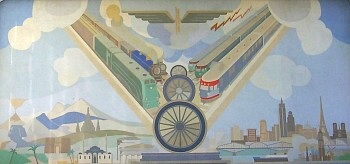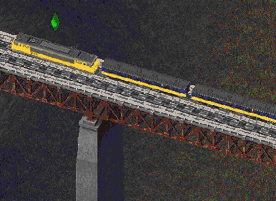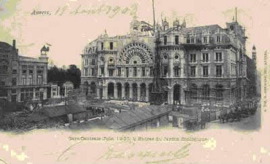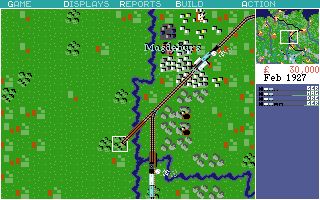Railroad Tycoon
Nobody knows it, but we’ve got a secret shame. By Romanista

Trains have held a fascination to me ever since I was a child. As my parents didn’t have a car, the train was our main form of transportation. When I was small, places like Groningen or Maastricht seemed to be exotic locations from the other end of the universe. Later we found ourselves in the great Termini of Europe: Paris Gare du Nord, Budapest Keleti or Milano Centrale. My dreams of travelling have always been connected to trains.
The closest station to my parents’ house was Amsterdam Amstel. It was built sometime before the war and still smells like the trains of yesterday. It has a beautiful mural, showing trains leaving Amsterdam, and going all the way to Berlin, Moscow and Ulaan-baator.
So, naturally, I have always been attracted to trains in videogames. I remember a Train simulation game made by a Dutch train operator on the Commodore 64. You could control a commuter train – an idea that Taito has recently made it’s own with Densha de Go (“Go by train”) first as an arcade game and then with many conversions for home systems including the N64, Playstation and Dreamcast. There is even a special controller to really make you feel like a train-engineer.

Other games left you in charge of operating the switches, giving you the task of preventing trains to crash. When more trains arrived this became a hectic operation, just like it is on large stations like Utrecht Central, where all Dutch trains come together.
In the real world trains were often used as a device to trigger city development. Paris had grown through its Metro, with speculants building new quarters and metro lines at the same time. Maxis therefore made Sim City Public-transport biased, focussing your choices and your freedom to build your own cities severely. It also made it a more European game then it’s American heritage would suggest.

I liked these games, but none of them really appealed to the romantic in me. It always seemed more like a chore to be worked through rather than a game to be played. I didn’t want to transport commuters to work; I wanted to leave Grand Central Station on my way to adventures in the Wild West. I wanted to go through 19th century cathedrals like Antwerp Central or pass Nakoya-station in the Shinkansen. I wanted to discover new worlds.
In 1991 came the answer. Just before we got our Amiga, I saw Railroad Tycoon on a friend’s PC, in shiny EGA. I couldn’t find it in the Netherlands, so I had to make do with playing it in emulated four colour CGA on my Amiga. But that didn’t matter.

You started small. Playing the tutorial you were asked to lay tracks in the American south, between Richmond and Virginia. Track for track your connected the cities. Your little steam train left your first station, with little bits of smoke coming out of the engine. A newspaper appeared showing the appreciation of the citizens. Soon you were bringing children to their grandmothers or helping lovely wine to be produced by carrying grapes to imaginary chateaus.
Like no other game, this game allowed you to travel to the countries of your dreams. You build you rails further and further, passing cities you only knew by name. The fact that you didn’t see much of how it looked, allowed you to imagine even more. As you couldn’t see the other side of the Alps on your screen, making a line from Munich to Turin really made you feel like a pioneer.
The strength of this game lies in its purity. The sequels (both official and unofficial) had fancy graphics, but RT simple straightforwardness gave your imagination the room it needed. Just like the book of the Hitchhikers guide gave you room to create your own universe, while the film just showed you a flawed story, RT allowed you to imagine your own travels to mysterious cities.
The people of Osijek celebrated when you reached there town. The people of Berlin voted Bismarck’s puny Leipzig & Magdeburg Railway out to favour your new service to Brussels. Your steam engines were bringing people together, with no car in sight to stop your growth.
The virtual people in Railroad Tycoon expressed their happiness of not being locked up in their city anymore. They were now connected to the real world. I imagined how I would feel, how people in the nineteenth century must have felt, if suddenly I couldn’t journey only to the nearest village in a day’s travel, but could go to a new city or even a new country.

Later, as an urban planner, I had to confront the real demands and wishes of travellers. I work in this sector now, managing projects regarding public bikes and mobile travel information.
Still sometimes when I talk to people working for a railway company, I see in their eyes that they share my dream as well – that they want to travel to far-away countries too. They look at the platform and see the ICE travelling to Cologne and Munich, to Moscow and Washington, to the world.
On those occasions, I go home and open my abandon-ware folder and run Railroad Tycoon once again. I build Bologna F.S. and lay tracks to Firenze Santa Maria Novella. And suddenly I’m in another country and another weekend is gone.
